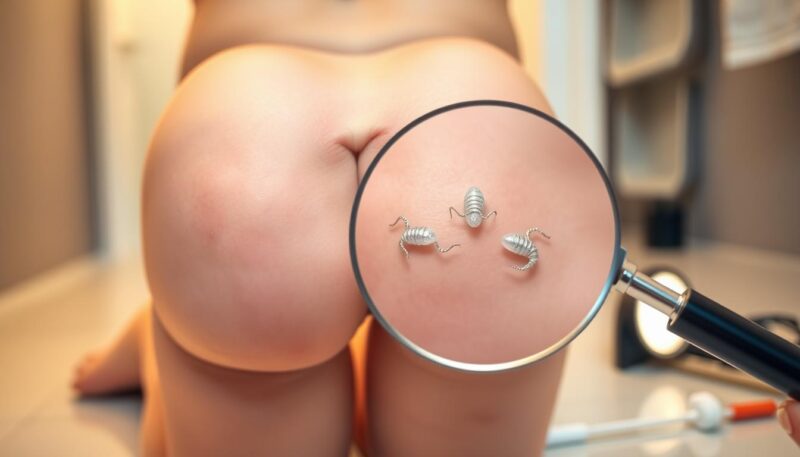Pinworm infections, the most prevalent type of intestinal infection in the United States, are a common concern for many families, especially those with children aged 5 to 10 years old. While nearly 1 billion people worldwide battle these pesky parasites, the good news is that the symptoms of pinworms in kids are relatively straightforward to recognize and treat. The most notable pinworm symptoms children experience include itching around the anal area, particularly at night, which can lead to sleep disruptions and increased irritability. This article aims to equip you with crucial knowledge on how to spot and address this common infection effectively.
Understanding Pinworms: What You Need to Know
Pinworm infections represent one of the most common intestinal worm infections in the United States. Understanding these infections, including their characteristics, modes of transmission, and at-risk populations, can significantly aid in pinworm prevention.
What Are Pinworms?
Pinworms are small, thin, white worms, measuring between 1/4 to 1/2 inch in length. These worms primarily inhabit the intestines of humans and are particularly notorious for causing discomfort during the night. Female pinworms migrate to the anal area, laying their eggs, leading to anal itching. This condition is often prevalent among children, making the topic of pinworms in kids an essential focus for many parents.
How Do Pinworm Infections Spread?
Pinworm infections spread easily, with the primary route being the ingestion of eggs. These eggs can linger on various surfaces, including bed linens, clothing, toys, and household dust, remaining viable for up to three weeks. Children often transfer these eggs to their mouths after scratching their anal area, contributing to the cycle of reinfection. Daycare pinworms are particularly common in environments where children congregate and play closely, facilitating transmission.
Who is at Higher Risk?
Children aged 5 to 10 are at a heightened risk for pinworm infections due to their frequent interactions in crowded settings like schools and daycares. Factors such as poor hygiene practices, including inadequate handwashing and nail-biting, further increase susceptibility. Awareness of these risk factors is crucial for effective pinworm prevention, ensuring children remain healthy and comfortable.
| Factor | Details |
|---|---|
| Age Group | Children aged 5 to 10 years are most affected |
| Transmission Mode | Ingestion of eggs from contaminated surfaces |
| Infection Duration | Eggs survive outside the body for 2-3 weeks |
| Common Locations | Clothes, bed linens, toys, play areas |
| Symptoms | Itching around the anus, especially at night |
Symptoms of Pinworms in Kids
Pinworm infections are a prevalent issue among children in the United States, particularly affecting those aged 5 to 10 years. Recognizing the symptoms is essential for prompt treatment. The most noticeable symptoms often arise during the night, leading to signs such as irritability and restless behavior.
Identifying Common Symptoms
The hallmark sign of a pinworm infection is the intense itching around the anus, especially at night. This condition often causes disturbances in sleep, as affected children might find it difficult to settle down. As an itchy bottom child, your little one may wake frequently during the night, contributing to fatigue and irritability during the day. Parents should remain vigilant for other signs, including:
- Restlessness and difficulty sleeping
- Irritability and mood swings
- Visible discomfort in the anal area
Less Common Symptoms and Behavioral Changes
While many children infected with pinworms exhibit no symptoms, some may experience occasional abdominal pain or nausea. These symptoms can sometimes lead to anxiety or changes in behavior. In some cases, infections may cause vaginal discharge in girls if pinworms spread to that area. Recognizing the signs is crucial, as untreated pinworm infections can lead to secondary issues. Awareness of how anal itching, particularly night itching kids experience, can inform decisions regarding medical consultations and treatments.

| Symptom | Description |
|---|---|
| Itching | Intense itching around the anus, particularly at night. |
| Sleep disturbances | Difficulties falling asleep or frequent awakenings. |
| Irritability | Mood swings and increased irritability during the day. |
| Abdominal discomfort | Occasional pain or nausea, which may cause anxiety. |
| Vaginal discharge | Possible discharge in girls if pinworms migrate to the vaginal area. |
How to Diagnose and Treat Pinworm Infections
Understanding how to diagnose and treat pinworm infections is crucial for maintaining your child’s health. These infections are common among school-age children and can lead to discomfort if not addressed promptly. Recognizing symptoms and following appropriate treatments can alleviate issues quickly.
How to Check for Pinworms
When you suspect a pinworm infection, you need to know how to check for pinworms effectively. Diagnosis often starts with an observation of symptoms like itching around the anus, especially at night. A tape test can confirm the presence of pinworm eggs. You should press clear tape around the anal area overnight and collect it in the morning. A healthcare provider can then examine it under a microscope.
Active Treatments: Medications and Dosage
For treatment, over-the-counter deworming medicine for children, such as mebendazole or pyrantel pamoate, is generally recommended. One dose usually suffices, followed by another dose two weeks later to ensure complete elimination of all pinworms and their eggs. It’s important to consult your healthcare provider for the appropriate dosage based on your child’s age and weight.
Household and Hygiene Measures
Implementing effective household pinworm treatment and hygiene for pinworms is essential to prevent reinfection. Regularly wash bedding, towels, and clothing in hot water to kill any lingering eggs. Encourage children to wash their hands frequently, particularly after using the bathroom and before meals. Keeping nails trimmed reduces the likelihood of eggs getting trapped and spreading throughout the household.

Conclusion
Pinworms, or Enterobius vermicularis, represent one of the most prevalent helminth infections globally, affecting approximately 40 million people in the United States alone. Particularly among children aged 5 to 14 years, the female predominance and high rates of infection necessitate awareness and swift action. This common yet often overlooked worm infection can lead to discomfort, primarily manifested as perianal itching that often disrupts sleep.
An effective approach to pinworm prevention encompasses both immediate worm infection treatment and diligent hygiene practices. Regular handwashing, morning baths, and trimmed fingernails significantly lower the risk of transmission. Additionally, treating all household members, irrespective of displaying symptoms, is vital to eradicating the infection and preventing recurrence, as reinfections are a common occurrence.
In conclusion, recognizing pinworm symptoms and implementing preventive strategies are crucial in managing this widespread infection. With appropriate medical treatments like mebendazole, albendazole, and pyrantel pamoate, alongside consistent hygiene habits, you can successfully address and reduce the risk of pinworm infections within your family and community.

